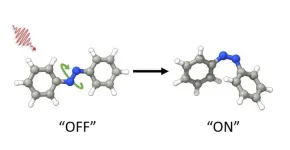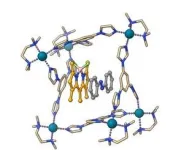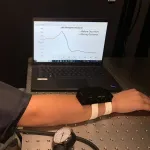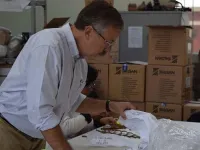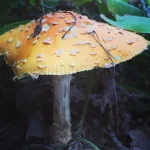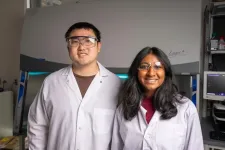(Press-News.org)
New discovery allows scientists to change the shape of azobenzene molecules using visible light, which is more practical and safe than previously used ultraviolet light. Azobenzenes are incredibly versatile and have many potential uses, such as in making tiny machines and improving technology as well as making light controllable drugs. This molecule can switch between two different forms by light. However, the two forms are in equilibrium, which means that a mixture present that prevents optimal use for applications. Being able to control them with visible light and enrich only one form opens up new possibilities for these applications, making them more efficient and accessible.
[Jerusalem] - Azobenzenes, versatile molecules with vast potential in various technological applications, have traditionally required ultraviolet light for photoisomerization. However, a new approach promises to change the game. Scientists, Profs. Igor Schapiro from Hebrew University of Jerusalem, Rafal Klajn from the Weizmann Institute of Science and Institute of Science and Technology Austria, and Arri Priimagi from Tampere University along with a team of researchers, have introduced a novel concept termed "disequilibration by sensitization under confinement" or DESC. This innovative approach offers for the first time the possibility of prompting a specific molecular transformation, specifically the conversion from an "E" to a "Z" state. They can be thought of as an “on” and “off” form in applications. This change can be triggered by visible light, including wavelengths in the red part of the visible spectrum.
The study, titled "Disequilibrating azobenzenes by visible-light sensitization under confinement," was recently published in the prestigious scientific journal, Science.
What makes Azobenzene molecules particularly interesting is their ability to undergo changes in their shape in response to specific types of light, including ultraviolet and visible light. This phenomenon, known as photoisomerization, enables azobenzenes to transition between two distinct shapes or isomers, the "E" and "Z" isomers. This unique attribute holds immense significance, as it unlocks a diverse spectrum of applications spanning nanotechnology, data storage, drug delivery, materials science, and biological research. In essence, azobenzenes serve as pivotal elements in numerous scientific and technological advancements.
"Through our computational studies and quantum chemical calculations, we've illuminated the path to an innovative approach, which not only advances the fundamental field of azobenzene but also paves the way for practical applications. These applications harness the power of visible light, including red wavelength of light." said Prof. Igor Schapiro, Hebrew University of Jerusalem
Azobenzenes are pivotal components in a wide range of technologies, from molecular switches and actuators to data storage and drug delivery systems. Until now, their photoisomerization necessitated ultraviolet light, limiting their applicability. However, DESC represents a significant breakthrough, offering a supramolecular approach that enables controlled E-to-Z isomerization with harmless light.
Key Highlights of the Study:
Novel Approach: DESC introduces a new supramolecular approach to azobenzene photoisomerization, enabling it with visible light, including red wavelengths.
Teamwork of Molecules: The combination of a special macrocyclic host and a photosensitizer is the secret behind DESC's success. They work together to pick out and change certain azobenzene molecules.
Unlocking New Opportunities: DESC leads to special photostationary states that were not possible to create directly with light before. This opens up lots of new possibilities for using azobenzenes in different ways.
This pioneering research opens up exciting new avenues for the utilization of azobenzenes across various fields. By broadening the range of light wavelengths that can induce isomerization, DESC promises to enhance the efficiency and applicability of azobenzene-based technologies.
END
In a new study in mice, a team of researchers from UCLA, the Swiss Federal Institute of Technology, and Harvard University have uncovered a crucial component for restoring functional activity after spinal cord injury. The neuroscientists have shown that re-growing specific neurons back to their natural target regions led to recovery, while random regrowth was not effective.
In a 2018 study published in Nature, the team identified a treatment approach that triggers axons — the tiny fibers that link nerve cells and enable them to communicate — to regrow after spinal cord injury ...
Imagine if humans could ‘talk’ to plants and warn them of approaching pest attacks or extreme weather.
A team of plant scientists at the Sainsbury Laboratory Cambridge University (SLCU) would like to turn this science fiction into reality using light-based messaging to ‘talk’ to plants.
Early lab experiments with tobacco (Nicotiana benthamiana) have demonstrated that they can activate the plant's natural defence mechanism (immune response) using light as a stimulus (messenger).
Light serves as a universal means of daily human communication, for example the signalling at traffic lights, pedestrian ...
Three independent state-of-the-art datasets reveal that the West Side has more nitrogen dioxide (NO2) pollution than the rest of the city
Depending on the month, residents in this area experience 16 to 32% higher NO2 concentrations on average
By identifying hotspots, residents and policymakers can be confident about where to prioritize immediate interventions
EVANSTON, Ill. — The western edge of Chicago — including the North and South Lawndale, East Garfield Park, Archer Heights and Brighton Park neighborhoods — experiences up to 32% higher concentrations of nitrogen dioxide (NO2) air pollution compared to the rest of the city, ...
ROCKVILLE, MD – The Biophysical Society is proud to announce its 2024 Society Fellows. This award honors the Society’s distinguished members who have demonstrated excellence in science and contributed to the expansion of the field of biophysics. The Fellows will be honored at the Biophysical Society’s 68th Annual Meeting, being held in Philadelphia, Pennsylvania from February 10-14, 2024. The 2024 Fellows are:
Rommie E. Amaro, University of California, San Diego, USA, is named a Biophysical Society Fellow for her work on developing methods to enable the simulation of biological molecules in situ and ...
WASHINGTON — Researchers have developed a wearable optical device for early detection of hemorrhage during labor or after childbirth. This serious heavy bleeding can be hard to detect before it becomes an emergency and accounts for almost 30% of maternal deaths globally and just over 10% of maternal deaths in the United States.
Studies have shown that early diagnosis and treatment for postpartum hemorrhage is the best way to prevent deaths. The new device is designed to be worn on the wrist, where it uses laser speckle imaging to continuously ...
PORTLAND, Oregon -- The United States’ most distinguished biomedical research award is being given to Oregon Health & Science University physician-scientist David Huang, M.D., Ph.D., for co-inventing an imaging technology that routinely helps prevent blindness and is increasingly used to diagnose and treat conditions of the heart, brain, skin and more.
Huang is receiving the 2023 Lasker-DeBakey Clinical Medical Research Award as a co-inventor of optical coherence tomography, or OCT, the Albert and ...
Violence was a consistent part of life among ancient communities of hunter-gatherers, according to a new study co-authored by a Tulane University researcher that looked for signs of trauma on 10,000-year-old skeletal remains from burial sites in northern Chile.
The study was published in the journal PLOS ONE.
Archaeological research has shown that interpersonal violence and warfare played an important role in the lives of hunter-gatherer groups over time. Still, many questions remain about the factors that influence such violence. The record of human populations in northern Chile extends across 10,000 years, providing a valuable opportunity to study patterns in violence over time.
John ...
Children are taught to leave wild mushrooms alone because of their potential to be poisonous. But trees on the other hand depend on fungi for their well-being. Look no further than ectomycorrhizal fungi, which are organisms that colonize the roots of many tree species where the boreal ecosystem (zone encompassing Earth’s northernmost forests) and the temperate ecosystem (zone between the tropical and boreal regions) meet. This area features a mix of boreal trees including needle-leaved evergreens and temperate tree species including maple and oak.
Just like a healthy human relationship, trees and fungi work well together because they help one another. When the ectomycorrhizal ...
HOUSTON – (Sept. 21, 2023) – To make a gene-editing tool more precise and easier to control, Rice University engineers split it into two pieces that only come back together when a third small molecule is added.
Researchers in the lab of chemical and biomolecular engineer Xue Sherry Gao created a CRISPR-based gene editor designed to target adenine ⎯ one of the four main DNA building blocks ⎯ that remains inactive when disassembled but kicks into gear once the binding molecule is added.
Compared to the intact original, the split editor is more precise and stays active for a narrower window of time, ...
It sounds like magic: photoelectrodes could convert the greenhouse gas CO2 back into methanol or N2 molecules into valuable fertiliser - using only the energy of sunlight. An HZB study has now shown that diamond materials are in principle suitable for such photoelectrodes. By combining X-ray spectroscopic techniques at BESSY II with other measurement methods, Tristan Petit's team has succeeded for the first time in precisely tracking which processes are excited by light as well as the crucial role of the surface of the diamond materials.
At first glance, lab-grown diamond materials ...
